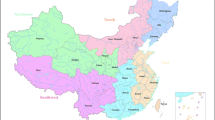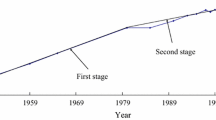Abstract
Since China has the largest population in the world, the available water resources per capita in China are very limited. With the rapid economic development that is currently occurring, the shortage of water resources at the national level has become extremely critical. How to solve the problems due to water scarcity and water pollution has received increasing attention from the Chinese government and various communities. In order to provide a sustainable development environment for 1.6 billion people in the future, the whole country has started to reform urban water resources management systems in terms of related policies, regulations, methodologies, and technologies focusing on improving the efficiency and effectiveness in water use. Urban water quota management has now become a core strategy in developing a water resources governance model for water demand management aiming at establishing a water-saving society. This paper introduces the main stages and the processes of implementing water quota management in China, analyzes the basic principles, and expounds the elements, information foundation, core module and operational model of the urban water quota management system. It has been demonstrated that urban water quota management has made some remarkable contribution not only in transforming the pattern of water mode and strengthening water management enforcement but also in integrating various management methods in saving water and preventing pollution.






Similar content being viewed by others
References
Baumann, D.D., J.J. Boland, and W.M. Hanemann. 1997. Urban water demand management and planning. New York: McGraw-Hill.
Bernhardi, L., G.E.G. Beroggi, and M.R. Moens. 2000. Sustainable water management through flexible method management. Water Resources Management 14: 473–495.
Butler, D., and F.A. Memon. 2006. Water demand management. New York: IWA Publishing.
Cao, K.T., E.K. Gao, and Z.J. Wang. 2003. Reading guidance of water law of People’s Republic of China. Beijing: China Legal Publishing House (in Chinese).
Cao, S.X., L. Chen, and Z. Liu. 2007. Disharmony between society and environmental carrying capacity: A historical review, with an emphasis on China. AMBIO 36: 409–415.
Chen, J.Q., H. Wang, and X.L. Yang. 2002. Science of water resources, 250 pp. Beijing: Science Press (in Chinese).
Dirksen, W. 2002. Water management structures in Europe. Irrigation and Drainage 51: 199–211.
Fu, T., M. Chang, and L.J. Zhong. 2006. Urban water industry reform of China: Practices and case studies, 2–7. Beijing: China Building Industry Press, 329 pp (in Chinese).
Gu, D.F. 2002. Scientific encyclopedia of China’s resources. Water Resources Section, China Water Information Website.
Haddad, M., and K. Lindner. 2001. Sustainable water demand management versus developing new and additional water in the Middle East: A critical review. Water Policy 3: 143–163.
Hong, A.L. 1997. Water resources development and protection and urban development. Anhui Geology 4: 44–46. (in Chinese).
Jiang, Y.L., and Y.S. Chen. 2007. Fixed management of the water exploration of universities in Beijing. Water and Wastewater Engineering 6: 68–72 (in Chinese).
Jiang, Y.L., Y.S. Chen, and J.P. He. 2008. Studies on principle of quota management of water resources. China Water Resources 17: 6–8 (in Chinese).
Jin, M.H., W.J. Tang, and L.L. Qi. 2004. Water quota principle for industrial enterprises products. China Standardization 2: 47–49 (in Chinese).
Liang, Y., S.K. Cheng, and Q.W. Min. 2003. Changes and the comparative study of water management models. Soil and Water Conservation Research 10: 35–37 (in Chinese).
Maksimovic, C., and J.A. Tejada-Guibert. 2001. Frontiers in urban water management: Deadlock or hope. New York: IWA Publishing.
Mohamed, A.S., and H.H.G. Savenije. 2000. Water demand management: Positive incentives, negative incentives or quota regulation? Physics and Chemistry of the Earth 25: 251–258.
Qian, Y., C.M. Liu, and Y.S. Shao. 2002. The water sustainable exploitation and utilization in cities of China. Beijing: China Water Power Press (in Chinese).
Ruan, B.Q., and C.J. Wei. 2004. The construction of the safety guarantee system of water resources in capital region. Beijing: Science Press (in Chinese).
Schachtschneider, K. 2002. Building new WDM regulations for the Namibian tourism sector on factors influencing current water-management practices at the enterprise level. Physics and Chemistry of the Earth 27: 859–864.
The Department for Environment, Comprehensive Utilization of Resources of State Development, Reform Commission. 2003. The implementation guidelines for water quota national standards of industrial enterprises. China Standard Press (in Chinese): Beijing.
The Ministry of Water Resources. 1999. Pertaining to the strengthened preparation and management of water quotas (in Chinese).
United Nations/World Water Assessment Programme. 2003. 1st UN World Water Development Report: Water for people, water for life. Paris: UNESCO and Berghahn Books. http://www.unesco.org/water/wwap/wwdr.
Acknowledgments
This work was funded by grants from the key projects of China National “Eleventh Five-Year” science and technology supporting plan: “Research on Comprehensive water resources allocation technology of South-to-North Water Diversion” (No. 2006BAB04A16).
Author information
Authors and Affiliations
Corresponding author
Rights and permissions
About this article
Cite this article
Jiang, Y., Chen, Y., Younos, T. et al. Urban Water Resources Quota Management: The Core Strategy for Water Demand Management in China. AMBIO 39, 467–475 (2010). https://doi.org/10.1007/s13280-010-0080-x
Received:
Revised:
Accepted:
Published:
Issue Date:
DOI: https://doi.org/10.1007/s13280-010-0080-x




